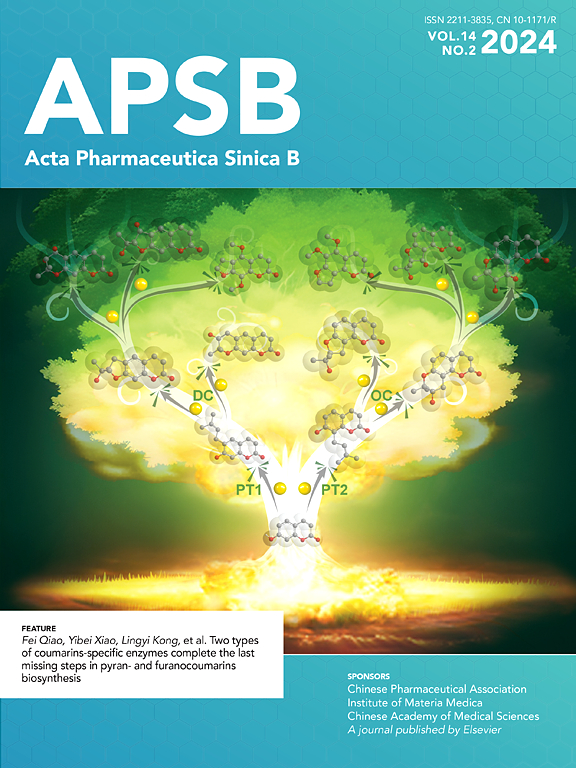Prodrug-based combinational nanomedicine remodels lipid metabolism for reinforced ferroptosis and immune activation
IF 14.6
1区 医学
Q1 PHARMACOLOGY & PHARMACY
引用次数: 0
Abstract
Ferroptosis is a form of programmed cell death characterized by overwhelmed lipid oxidation, and it has emerged as a promising strategy for cancer therapy. Enhanced ferroptosis could overcome the limitations of conventional therapeutic modalities, particularly in difficult-to-treat tumors. In this study, we developed a dual-modality therapy in nanomedicine by combining paclitaxel (PTX) chemotherapy and pyropheophorbide-a (Ppa) phototherapy. Heparin (HP) was grafted with poly(N-(2′-hydroxy) propyl methacrylamide) (pHPMA) using reversible addition–fragmentation chain transfer polymerization to form HP-pHPMA (HH), which was utilized to deliver Ppa and PTX, yielding HP-pHPMA-Ppa (HH-Ppa) and HP-pHPMA-PTX (HH-PTX), respectively. The prodrug-based combinational nanomedicine (HH-PP) was formed by co-assembly of HH-PTX and HH-Ppa. It was found that HH-PP treatment significantly disrupted lipid metabolism in triple-negative breast cancer (TNBC) cells, induced extensive lipid oxidation, and promoted ferroptosis. In vivo, HH-PP intervention achieved a tumor growth inhibition rate of 86.63% and activated adaptive immunity with an elevated CD8+ cytotoxic T cell infiltration level. This combinational nanomedicine offers a promising platform for co-delivery of multiple therapeutic agents. It exerts a promising anti-tumor effect via enhanced ferroptosis and ferroptosis-induced immune activation by disrupting lipid metabolism in TNBC cancer cells.

以前药为基础的联合纳米药物重塑脂质代谢,增强铁下沉和免疫激活
铁凋亡是一种程序性细胞死亡的形式,其特征是过度脂质氧化,它已成为一种有前途的癌症治疗策略。增强铁下垂可以克服传统治疗方式的局限性,特别是在难以治疗的肿瘤。在本研究中,我们开发了紫杉醇(PTX)化疗和焦酚a (Ppa)光疗相结合的纳米医学双模治疗方法。将肝素(HP)与聚(N-(2′-羟基)丙基甲基丙烯酰胺(pHPMA)通过可逆加成-断裂链转移聚合接枝,形成HP-pHPMA (HH),用于传递Ppa和PTX,分别得到HP-pHPMA-Ppa (HH-Ppa)和HP-pHPMA-PTX (HH-PTX)。将HH-PTX和HH-Ppa共组装形成前药基组合纳米药物(HH-PP)。研究发现,HH-PP治疗显著破坏三阴性乳腺癌(TNBC)细胞的脂质代谢,诱导广泛的脂质氧化,并促进铁下垂。在体内,HH-PP干预实现了86.63%的肿瘤生长抑制率,激活了适应性免疫,CD8+细胞毒性T细胞浸润水平升高。这种联合纳米药物为多种治疗药物的联合递送提供了一个有前途的平台。它通过破坏TNBC癌细胞的脂质代谢,增强铁凋亡和铁凋亡诱导的免疫激活,具有良好的抗肿瘤作用。
本文章由计算机程序翻译,如有差异,请以英文原文为准。
求助全文
约1分钟内获得全文
求助全文
来源期刊

Acta Pharmaceutica Sinica. B
Pharmacology, Toxicology and Pharmaceutics-General Pharmacology, Toxicology and Pharmaceutics
CiteScore
22.40
自引率
5.50%
发文量
1051
审稿时长
19 weeks
期刊介绍:
The Journal of the Institute of Materia Medica, Chinese Academy of Medical Sciences, and the Chinese Pharmaceutical Association oversees the peer review process for Acta Pharmaceutica Sinica. B (APSB).
Published monthly in English, APSB is dedicated to disseminating significant original research articles, rapid communications, and high-quality reviews that highlight recent advances across various pharmaceutical sciences domains. These encompass pharmacology, pharmaceutics, medicinal chemistry, natural products, pharmacognosy, pharmaceutical analysis, and pharmacokinetics.
A part of the Acta Pharmaceutica Sinica series, established in 1953 and indexed in prominent databases like Chemical Abstracts, Index Medicus, SciFinder Scholar, Biological Abstracts, International Pharmaceutical Abstracts, Cambridge Scientific Abstracts, and Current Bibliography on Science and Technology, APSB is sponsored by the Institute of Materia Medica, Chinese Academy of Medical Sciences, and the Chinese Pharmaceutical Association. Its production and hosting are facilitated by Elsevier B.V. This collaborative effort ensures APSB's commitment to delivering valuable contributions to the pharmaceutical sciences community.
 求助内容:
求助内容: 应助结果提醒方式:
应助结果提醒方式:


